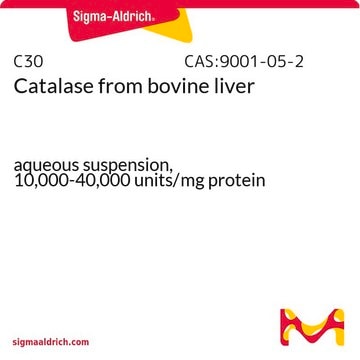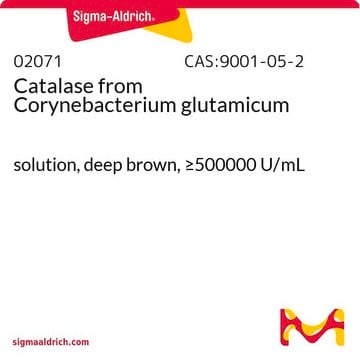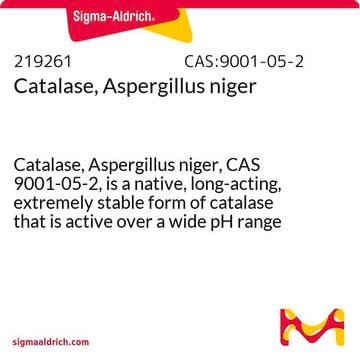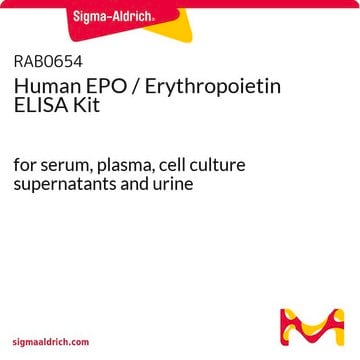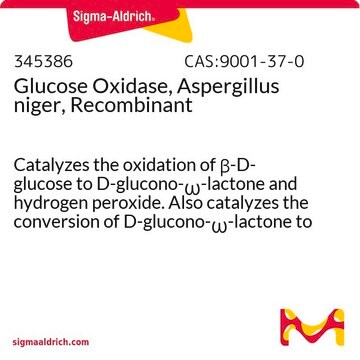C3155
Catalase from bovine liver
aqueous solution, ≥30,000 units/mg protein
Sinonimo/i:
H2O2:H2O2 oxidoreductase
About This Item
Prodotti consigliati
Origine biologica
bovine liver
Livello qualitativo
Descrizione
optimum pH ~ 7.0
Sterilità
aseptically filled
Forma fisica
aqueous solution
Attività specifica
≥30,000 units/mg protein
PM
tetramer ~250 kDa
contiene
≤0.10 mg/mL Thymol
Composizione
ammonium sulphate, 30-50%
catalase, 10-20%
Condizioni di stoccaggio
(Tightly closed. Keep locked up or in an area accessible only to qualified or authorized
persons)
tecniche
activity assay: suitable
Punto isoelettrico
5.4
pI
5.4
N° accesso UniProt
Condizioni di spedizione
wet ice
Temperatura di conservazione
2-8°C
InChI
1S/C9H10O3/c1-2-12-9(11)7-3-5-8(10)6-4-7/h3-6,10H,2H2,1H3
NUVBSKCKDOMJSU-UHFFFAOYSA-N
Informazioni sul gene
cow ... CAT(280743)
Cerchi prodotti simili? Visita Guida al confronto tra prodotti
Descrizione generale
Catalase from bovine liver is a tetramer consisting of 4 equal subunits each with a 60 kDa molecular weight. Each of these subunits contains iron bound to a protoheme IX group. The enzyme will also strongly bind to NADP, where NADP and the heme group are within 13.7 angstroms.
Catalase from bovine is a tetrameric enzyme, consisting of four identical sub-units containing a single heme moiety per subunit. Each subunit has four domains like the α-helical domain, an eight-stranded β-barrel, N-terminal threading arm that is connected to the β-barrel via a wrapping loop.
Applicazioni
- as a component of the GLOX buffer during single molecule fluorescent in situ hybridization (smFISH) on primary mouse cortical neurons
- for its structural and kinetic analysis of its interaction with nitric oxide
- in the preparation of glucose oxidase-catalase system (GOX-CAT system) to generate H2O2 and study the effect of H2O2-induced oxidative stress on myelination in mouse organotypic cerebellar slice cultures
Catalase from bovine liver may be used:
- to prepare H2O2-O2 based biocathode for applications in glucose biofuel cells
- to study the kinetic properties and storage stability of catalase immobilized on to florisil
- in glutathione-mediated superoxide generation in an aqueous solution
Azioni biochim/fisiol
Avvertenza
Definizione di unità
Nota sulla preparazione
Inibitore
Avvertenze
Danger
Indicazioni di pericolo
Consigli di prudenza
Classi di pericolo
Resp. Sens. 1
Codice della classe di stoccaggio
12 - Non Combustible Liquids
Classe di pericolosità dell'acqua (WGK)
WGK 1
Punto d’infiammabilità (°F)
Not applicable
Punto d’infiammabilità (°C)
Not applicable
Dispositivi di protezione individuale
Eyeshields, Gloves, multi-purpose combination respirator cartridge (US)
Certificati d'analisi (COA)
Cerca il Certificati d'analisi (COA) digitando il numero di lotto/batch corrispondente. I numeri di lotto o di batch sono stampati sull'etichetta dei prodotti dopo la parola ‘Lotto’ o ‘Batch’.
Possiedi già questo prodotto?
I documenti relativi ai prodotti acquistati recentemente sono disponibili nell’Archivio dei documenti.
I clienti hanno visto anche
Protocolli
This procedure may be used for all Catalase products.
Il team dei nostri ricercatori vanta grande esperienza in tutte le aree della ricerca quali Life Science, scienza dei materiali, sintesi chimica, cromatografia, discipline analitiche, ecc..
Contatta l'Assistenza Tecnica.
